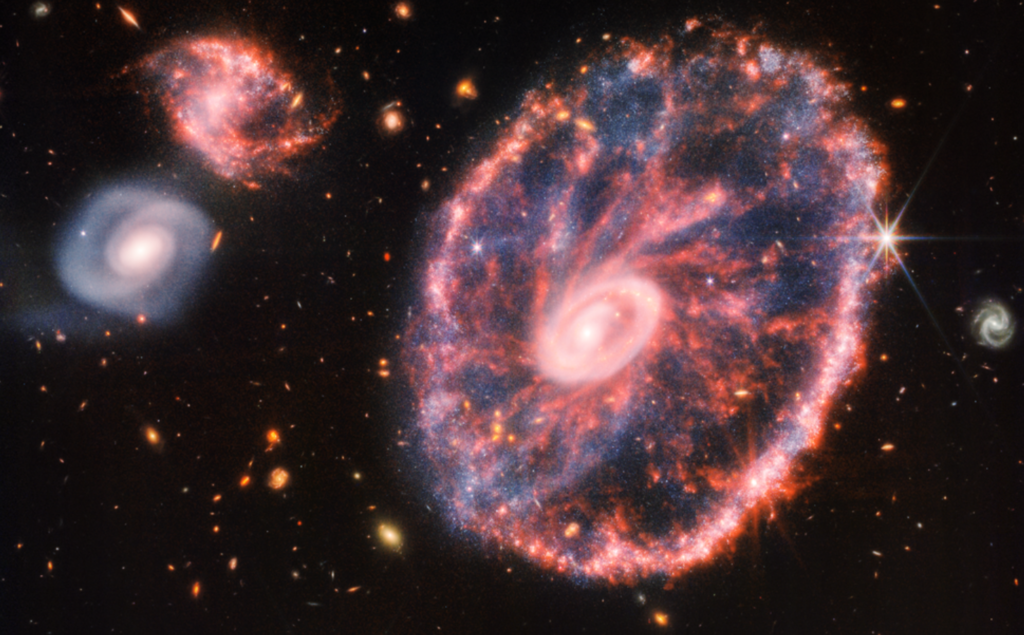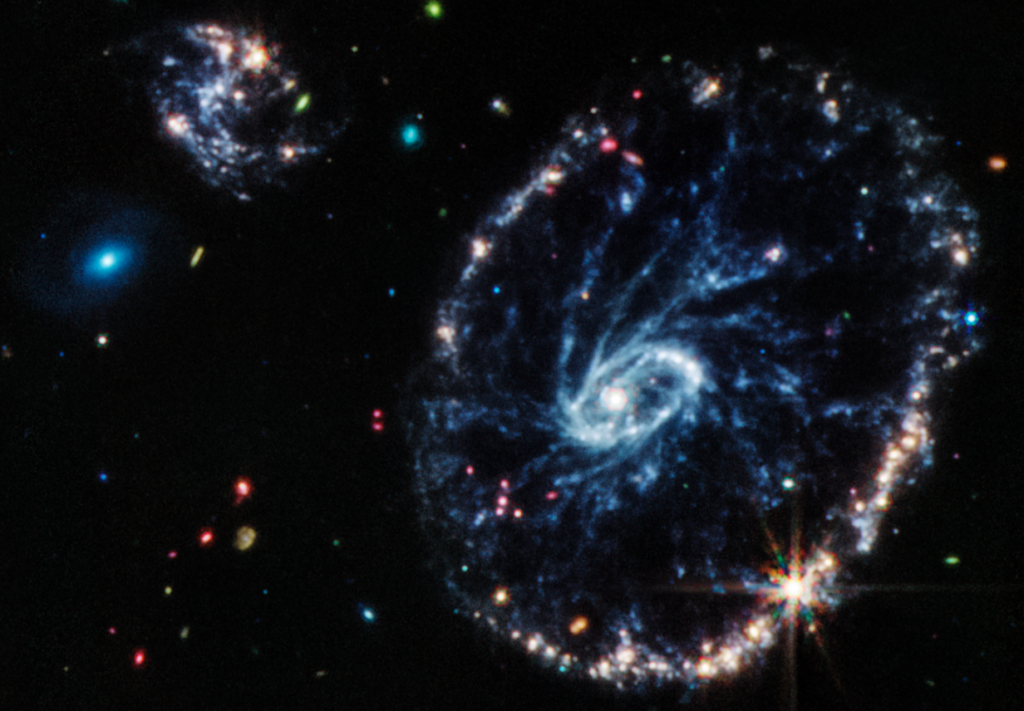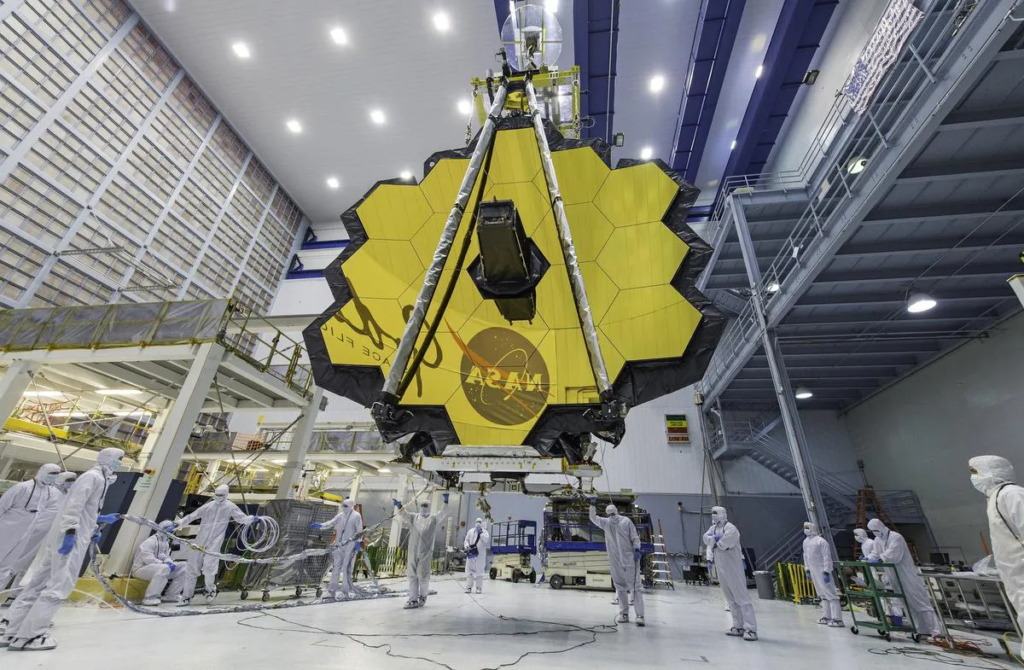
Brand New Incredible Images From Webb
The James Webb Space Telescope is by far the most advanced observatory ever sent into space. These added features and size made the journey quite complicated but are now paying off with some of the most detailed and accurate images ever taken of the Universe. After releasing some of the first images earlier last month, Webb is continuing to take more with no plan of stopping.
Specifically, just yesterday the JWST peered into the chaos of the Cartwheel Galaxy, revealing new details about star formation and the galaxy’s central black hole. Webb’s powerful infrared gaze produced this detailed image of the Cartwheel and two smaller companion galaxies against a backdrop of many other galaxies. Just one of the multiple new images giving scientists a bunch of information.
So far since the launch of the James Webb Space Telescope late last year, Webb has done nothing but continually prove to operate better than expected. As time goes on we can hope that the telescope continues to work just as well and produce even more images. Here I will go more in-depth into the recent images released, what to expect from Webb in the coming months, and more.
Recent Updates

Just yesterday NASA tweeted saying, “Webb is on a roll! This new @NASAWebb near and mid-infrared composite image highlights the Cartwheel Galaxy, the result of a high-speed collision that occurred about 440 million years ago, along with two neighboring galaxies.” Specifically, NASA’s James Webb Space Telescope recently peered into the chaos of the Cartwheel Galaxy, revealing new details about star formation and the galaxy’s central black hole. Webb’s powerful infrared gaze produced this detailed image of the Cartwheel and two smaller companion galaxies against a backdrop of many other galaxies. This image provides a new view of how the Cartwheel Galaxy has changed over billions of years.
NASA highlights that the Cartwheel Galaxy, located about 500 million light-years away in the Sculptor constellation, is a rare sight. Its appearance, much like that of a wagon wheel, is the result of an intense event – a high-speed collision between a large spiral galaxy and a smaller galaxy not visible in this image. Collisions of galactic proportions cause a cascade of different, smaller events between the galaxies involved; the Cartwheel is no exception. The collision most notably affected the galaxy’s shape and structure. The Cartwheel Galaxy sports two rings — a bright inner ring and a surrounding, colorful ring. These two rings expand outwards from the center of the collision, like ripples in a pond after a stone is tossed into it. Because of these distinctive features, astronomers call this a “ring galaxy,” a structure less common than spiral galaxies like our Milky Way.
The bright core contains a tremendous amount of hot dust with the brightest areas being the home to gigantic young star clusters. On the other hand, the outer ring, which has expanded for about 440 million years, is dominated by star formation and supernovas. As this ring expands, it plows into surrounding gas and triggers star formation. Other telescopes, including the Hubble Space Telescope, have previously examined the Cartwheel. But the dramatic galaxy has been shrouded in mystery – perhaps literally, given the amount of dust that obscures the view. Webb, with its ability to detect infrared light, now uncovers new insights into the nature of the Cartwheel. The Near-Infrared Camera (NIRCam), Webb’s primary imager, looks in the near-infrared range from 0.6 to 5 microns, seeing crucial wavelengths of light that can reveal even more stars than observed in visible light. This is because young stars, many of which are forming in the outer ring, are less obscured by the presence of dust when observed in infrared light. In this image, NIRCam data are colored blue, orange, and yellow. The galaxy displays many individual blue dots, which are individual stars or pockets of star formation. NIRCam also reveals the difference between the smooth distribution or shape of the older star populations and dense dust in the core compared to the clumpy shapes associated with the younger star populations outside of it.
Learning finer details about the dust that inhabits the galaxy, however, requires Webb’s Mid-Infrared Instrument (MIRI). MIRI data are colored red in this composite image. It reveals regions within the Cartwheel Galaxy rich in hydrocarbons and other chemical compounds, as well as silicate dust, like much of the dust on Earth. These regions form a series of spiraling spokes that essentially form the galaxy’s skeleton. These spokes are evident in previous Hubble observations released in 2018, but they become much more prominent in this Webb image. Webb’s observations underscore that the Cartwheel is in a very transitory stage. The galaxy, which was presumably a normal spiral galaxy like the Milky Way before its collision, will continue to transform. While Webb gives us a snapshot of the current state of the Cartwheel, it also provides insight into what happened to this galaxy in the past and how it will evolve in the future.
Webb’s Future

Now that we know more about some of the new fascinating images from Webb, we can take a closer look at the telescope’s future and what to expect. The observatory has a packed schedule of science programs looking at all kinds of cosmic phenomena, like planets, stars, galaxies, black holes, and more. Webb will revolutionize our understanding of the universe — but first, researchers need time to analyze data and make sure that they understand what they’re seeing. While we have already received quite a few images starting July 12th and now only days ago, NASA highlights that more images are coming. The agency will be rolling out even more in the coming weeks. It’s important to point out that NASA does not immediately release the images after receiving them. In other words, before NASA publicizes results in news materials, they wait for the findings to be peer-reviewed — meaning, the science community has assessed the results. The agency points out that science is a collaborative process of asking questions, testing out ideas, discussing with colleagues, and doing it all over. The peer-review process generally happens when researchers submit their findings to a journal or conference.
In addition to these future images we can expect from Webb, NASA recently spoke to Senior Project Scientist John Mather after some of the initial images were released. He mentioned, “It was worth the wait! Our immense golden telescope is seeing where none have seen before, discovering what we never knew before, and we are proud of what we have done. It’s our day to thank the people who made it possible, from the scientific visionaries in 1989 and 1995, to the 20,000 engineers, technicians, computer programmers, and scientists who did the work, and to the representatives of the people in the U.S., Europe, and Canada, who had faith in us and supported us. And special thanks to Senator Barbara Mikulski, who saved not one but two telescopes, with her inspiration and determination that setbacks are never the end. And special thanks to Goddard Project Manager Bill Ochs and Northrop Grumman Project Manager Scott Willoughby, who together pulled us all through every challenge to complete success.
“Already we have stood on the shoulders of giants like the Hubble and Spitzer space telescopes, and seen farther. We have seen distant galaxies, as they were when the universe was less than a billion years old, and we’re just beginning the search. We have seen galaxies colliding and merging, revealing their chemical secrets. We have seen one black hole close up, in the nucleus of a nearby galaxy, and measured the material escaping from it. We’ve seen the debris when a star exploded, liberating the chemical elements that will build the next generations of stars and planets. We have started a search for Earth 2.0, by watching a planet transiting in front of its star, and measuring the molecules in its atmosphere. “With the precise launch on Christmas morning 2021, we look forward to 20 years of operation before we run out of propellant. Though we suffer the pings of tiny micrometeoroids, so tiny you couldn’t feel one if you had it in your fingers, we think the telescope can meet its original performance likely long beyond its five-year design life. In 2027 we will launch the Nancy Grace Roman Space Telescope, which will scan vast areas of the sky for new fascinating targets for Webb, while also hunting for the effects of dark matter and dark energy. We know the Webb images will rewrite our textbooks, and we hope for a new discovery, something so important that our view of the universe will be overturned once again.
Conclusion
The James Webb Space Telescope seems to be working much better than expected. It has only been a few weeks since the first images were released and the next generation telescope is already providing even more fascinating images. As time goes on we can expect Webb to keep up the good work. We will have to wait and see how it progresses and the impact it has on the space industry.
